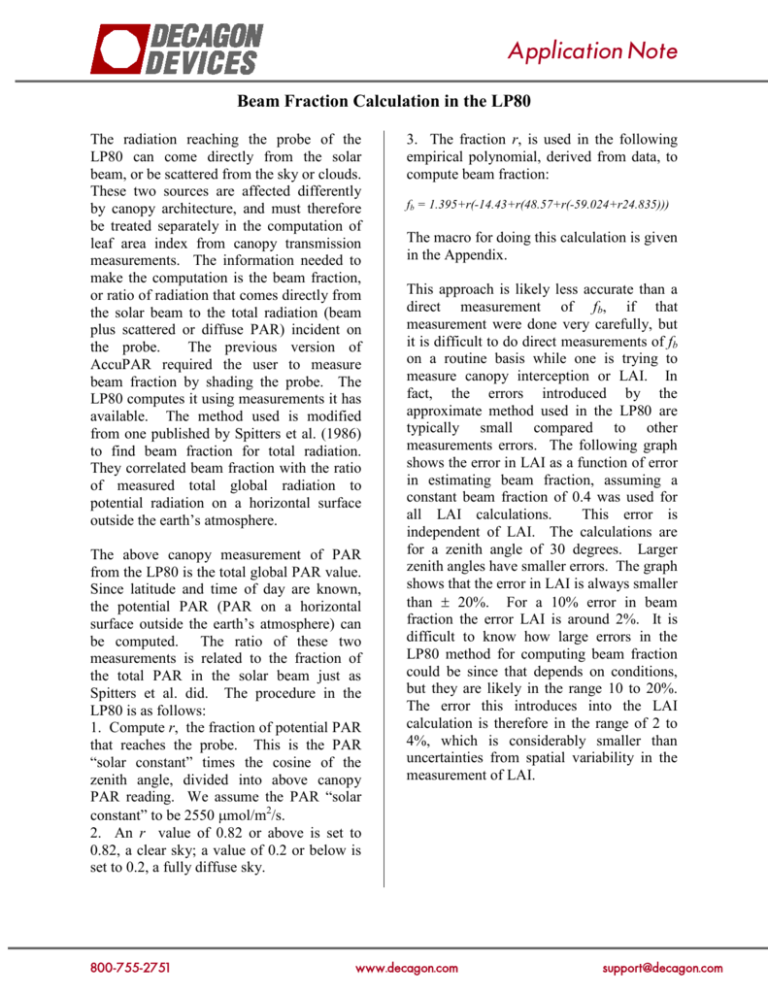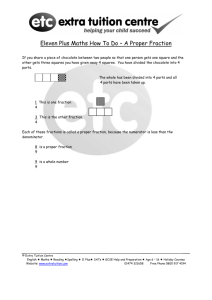
Application Note
Beam Fraction Calculation in the LP80
The radiation reaching the probe of the
LP80 can come directly from the solar
beam, or be scattered from the sky or clouds.
These two sources are affected differently
by canopy architecture, and must therefore
be treated separately in the computation of
leaf area index from canopy transmission
measurements. The information needed to
make the computation is the beam fraction,
or ratio of radiation that comes directly from
the solar beam to the total radiation (beam
plus scattered or diffuse PAR) incident on
the probe.
The previous version of
AccuPAR required the user to measure
beam fraction by shading the probe. The
LP80 computes it using measurements it has
available. The method used is modified
from one published by Spitters et al. (1986)
to find beam fraction for total radiation.
They correlated beam fraction with the ratio
of measured total global radiation to
potential radiation on a horizontal surface
outside the earth’s atmosphere.
The above canopy measurement of PAR
from the LP80 is the total global PAR value.
Since latitude and time of day are known,
the potential PAR (PAR on a horizontal
surface outside the earth’s atmosphere) can
be computed. The ratio of these two
measurements is related to the fraction of
the total PAR in the solar beam just as
Spitters et al. did. The procedure in the
LP80 is as follows:
1. Compute r, the fraction of potential PAR
that reaches the probe. This is the PAR
“solar constant” times the cosine of the
zenith angle, divided into above canopy
PAR reading. We assume the PAR “solar
constant” to be 2550 µmol/m2/s.
2. An r value of 0.82 or above is set to
0.82, a clear sky; a value of 0.2 or below is
set to 0.2, a fully diffuse sky.
800-755-2751
3. The fraction r, is used in the following
empirical polynomial, derived from data, to
compute beam fraction:
fb = 1.395+r(-14.43+r(48.57+r(-59.024+r24.835)))
The macro for doing this calculation is given
in the Appendix.
This approach is likely less accurate than a
direct measurement of fb, if that
measurement were done very carefully, but
it is difficult to do direct measurements of fb
on a routine basis while one is trying to
measure canopy interception or LAI. In
fact, the errors introduced by the
approximate method used in the LP80 are
typically small compared to other
measurements errors. The following graph
shows the error in LAI as a function of error
in estimating beam fraction, assuming a
constant beam fraction of 0.4 was used for
all LAI calculations.
This error is
independent of LAI. The calculations are
for a zenith angle of 30 degrees. Larger
zenith angles have smaller errors. The graph
shows that the error in LAI is always smaller
than ± 20%. For a 10% error in beam
fraction the error LAI is around 2%. It is
difficult to know how large errors in the
LP80 method for computing beam fraction
could be since that depends on conditions,
but they are likely in the range 10 to 20%.
The error this introduces into the LAI
calculation is therefore in the range of 2 to
4%, which is considerably smaller than
uncertainties from spatial variability in the
measurement of LAI.
www.decagon.com
support@decagon.com
LAI Error (Percent)
Application Note
25
20
15
10
5
0
-5
-10
-15
-20
-100
y = 0.1801x + 2.0852
R2 = 0.9808
-50
0
50
100
Beam Fraction Error (Percent)
Reference
Spitters, C. J. T., H. A. J. M Toussaint and J. Goudriaan. 1986. Separating the diffuse and direct
component of global radiation and its implications for modeling canopy photosynthesis. Part I.
Components of incoming radiation. Agric. Forest Meteorology 38:217-229.
Appendix: Visual BASIC macro for computing beam fraction
Function BeamFraction(Zenith As Single, PAR As Single) As Single
Const pi = 3.14159
Dim r As Single, b As Single
Zenith = Zenith * pi / 180
If Zenith > 1.5 Then
b = 0#
'nighttime
Else
r = PAR / (2550# * Cos(Zenith)) '600 w/m2 * 4.25 umol/w/m2 (.235 MJ/mol)(600 is potential
PAR)
If r > 0.82 Then r = 0.82
If r < 0.2 Then r = 0.2
b = 48.57 + r * (-59.024 + r * 24.835)
b = 1.395 + r * (-14.43 + r * b)
End If
BeamFraction = b
End Function
Decagon Devices, Inc.
2365 NE Hopkins Court
Pullman, WA 99163
support@decagon.com
www.decagon.com
13469-01 © 2009 Decagon Devices, Inc. All rights reserved.
800-755-2751
www.decagon.com
support@decagon.com






